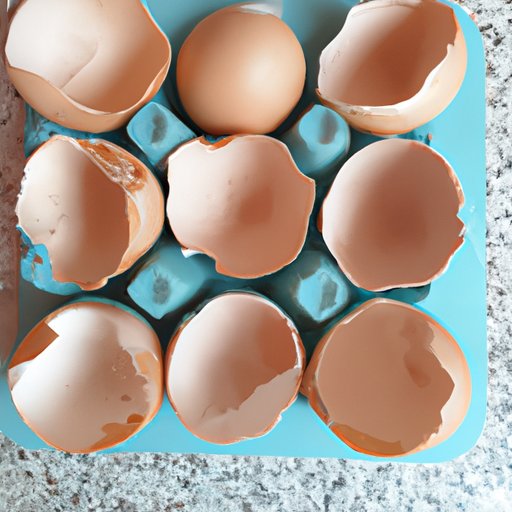Introduction
Eggs are a staple food item in many people’s diets. They are relatively inexpensive, versatile, and packed with nutritional value, making them a great source of protein for breakfast, lunch, and dinner. But with eggs comes a certain degree of risk; if not handled properly, eggs can become contaminated with bacteria like Salmonella, leading to food poisoning. As such, it’s important to know how to tell if an egg is still good before consuming it.
In this article, we will explore how to tell if an egg is still good by checking the expiration date on the egg carton, looking for signs of cracks or other damage to the eggshell, floating the egg in a bowl of cold water and observing whether it sinks or floats, breaking an egg open and smelling it for any unpleasant odors, and inspecting the egg white and yolk for any discoloration or off-putting textures.

Check the expiration date on the egg carton
The first thing to do when determining if an egg is still good is to check the expiration date on the egg carton. The expiration date is the date at which the egg should no longer be consumed, as it may have gone bad by that point. It is important to note that the expiration date does not necessarily mean the egg has gone bad; it simply means that after that date, you should use caution when consuming the egg.
It’s also important to keep in mind that expiration dates can vary from one manufacturer to the next. For example, some manufacturers may list the “sell by” date, while others may list the “best before” date. As such, it’s important to read the label carefully to determine what the expiration date actually means. Generally speaking, eggs should be consumed within three to five weeks of purchase.
Look for signs of cracks or other damage to the eggshell
Another way to tell if an egg is still good is to look for signs of cracks or other damage to the eggshell. Cracks or holes in the shell can indicate that the egg is no longer safe to eat, as bacteria can enter through these openings and contaminate the egg. Additionally, if the eggshell appears to be discolored or slimy, it is likely a sign that the egg has gone bad.
When inspecting the eggshell, it’s important to use a flashlight or other bright light to get a better view of the shell. Additionally, it’s best to inspect the eggshell before cracking it open, as the egg white and yolk can make it more difficult to spot any cracks or other damage.

Float the egg in a bowl of cold water and observe whether it sinks or floats
Floating an egg in a bowl of cold water is another simple test for determining if an egg is still good. If the egg sinks to the bottom of the bowl, then it is likely still good. However, if the egg floats to the top of the bowl, then it is likely no longer safe to eat. This is because the air cell inside the egg expands over time, causing the egg to float.
To conduct this test, fill a bowl with cold water and gently lower the egg into the water. If the egg sinks to the bottom, then it is still good. If the egg floats to the top, then it is likely no longer safe to eat and should be discarded.

Break an egg open and smell it for any unpleasant odors
Smelling an egg is another simple test for determining if an egg is still good. If the egg has a pleasant, slightly sweet smell, then it is likely still good. However, if the egg has a strong, unpleasant odor, then it is likely no longer safe to eat. This is because spoiled eggs produce sulfur gas, which gives off a strong, unpleasant odor.
To safely break open an egg, crack it against the side of a bowl and gently peel away the eggshell. Once the egg is opened, take a whiff and see if there is any unpleasant odor. If there is, then the egg is likely no longer safe to eat and should be discarded.
Inspect the egg white and yolk for any discoloration or off-putting textures
The final test for determining if an egg is still good is to inspect the egg white and yolk for any discoloration or off-putting textures. If the egg white and yolk appear normal, with no discoloration or strange textures, then the egg is likely still good. However, if the egg white and yolk look discolored or have an off-putting texture, then the egg is likely no longer safe to eat.
To inspect the egg white and yolk, gently break open the egg and take a close look at both. If they appear normal with no discoloration or off-putting textures, then the egg is likely still good. However, if they appear discolored or have an odd texture, then the egg is likely no longer safe to eat and should be discarded.
Conclusion
In summary, it is important to know how to tell if an egg is still good before consuming it. To do this, you should check the expiration date on the egg carton, look for signs of cracks or other damage to the eggshell, float the egg in a bowl of cold water and observe whether it sinks or floats, break an egg open and smell it for any unpleasant odors, and inspect the egg white and yolk for any discoloration or off-putting textures. Always remember to always check the expiration date, eggshell, smell, and texture before consuming eggs.
(Note: Is this article not meeting your expectations? Do you have knowledge or insights to share? Unlock new opportunities and expand your reach by joining our authors team. Click Registration to join us and share your expertise with our readers.)
